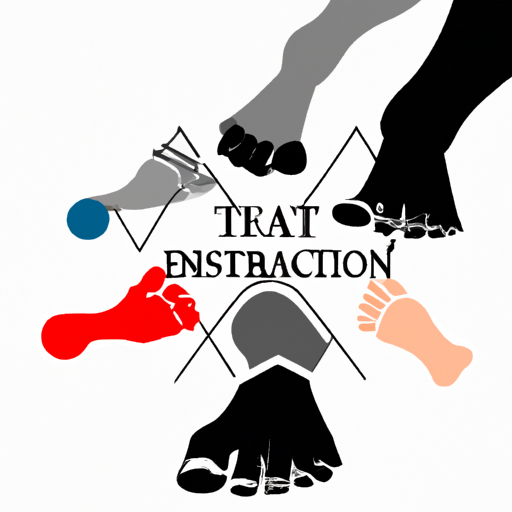Flat feet, also known as fallen arches, is a common condition that affects millions of people worldwide. While some individuals are born with flat feet, others may develop this condition over time. Flat feet can cause pain, discomfort, and an altered gait, impacting the overall quality of life. In this article, we will explore the causes, symptoms, and diagnosis of flat feet, as well as effective treatment options ranging from orthotics to physical therapy. Additionally, we will discuss lifestyle modifications and exercises that can help prevent and manage flat feet, ultimately promoting better foot health and overall well-being.
1. Understanding Flat Feet: Causes, Symptoms, and Diagnosis
Flat feet, also known as fallen arches, is a common condition where the arches of the feet are flattened, causing the entire sole of the foot to come into contact with the ground. This condition can affect both children and adults and may lead to various symptoms and discomfort. Understanding the causes, symptoms, and diagnosis of flat feet is crucial to effectively manage and treat this condition.
The primary cause of flat feet is the weakening or stretching of the tendons and ligaments that support the arches of the feet. This can be congenital, meaning a person is born with flat feet, or it can develop over time due to factors such as obesity, aging, injury, or certain medical conditions like rheumatoid arthritis or diabetes. Additionally, excessive pronation or rolling inward of the feet during walking can contribute to the development of flat feet.
Symptoms of flat feet can vary from person to person. Some individuals may experience no symptoms at all, while others may suffer from pain and discomfort in the feet, ankles, and lower legs. The pain may worsen with standing or walking for long periods, and individuals with flat feet may also notice a decrease in their balance and stability. It is important to note that flat feet can also lead to other foot problems, such as bunions, hammertoes, or plantar fasciitis.
Diagnosing flat feet typically involves a physical examination by a healthcare professional. They will assess the structure of the feet, observe the individual's gait, and may also request
2. Effective Treatment Options for Flat Feet: From Orthotics to Physical Therapy
Flat feet, or pes planus, is a common condition where the arches of the feet are either absent or significantly lower than normal. While it may not cause any discomfort or problems for some individuals, others may experience pain, fatigue, or difficulties with mobility. Fortunately, there are several effective treatment options available for individuals with flat feet, ranging from orthotics to physical therapy.
Orthotics, also known as shoe inserts, are commonly recommended for individuals with flat feet. These devices provide additional support to the arches and help to distribute weight evenly across the feet. There are different types of orthotics available, including over-the-counter inserts and custom-made orthotics. Over-the-counter inserts can be purchased without a prescription and are suitable for individuals with mild flat feet. On the other hand, custom-made orthotics are specifically designed to fit the individual's feet and provide maximum support. These are often recommended for individuals with more severe flat feet or those who require additional support due to specific foot conditions.
Physical therapy is another effective treatment option for flat feet. A trained physical therapist can develop a customized exercise program to strengthen the muscles and improve the stability of the feet and ankles. These exercises may include stretching, balance training, and strengthening exercises. Physical therapy can also help improve the overall biomechanics of the feet, leading to better foot function and reduced pain.
In some cases, flat feet may be caused by an underlying condition, such as tendon dysfunction or a structural abnormality in the bones of the feet. In such instances,
3. Prevention and Management of Flat Feet: Lifestyle Modifications and Exercises
Prevention and Management of Flat Feet: Lifestyle Modifications and Exercises
While flat feet may not always be preventable, there are certain lifestyle modifications and exercises that can help manage the condition and alleviate discomfort. These measures aim to strengthen the muscles and improve the flexibility of the feet, thereby reducing pain and preventing further complications. Here are some effective strategies for prevention and management of flat feet:
1. Choosing the right footwear: Wearing appropriate shoes is crucial for individuals with flat feet. Opt for shoes with good arch support and cushioning to provide stability and reduce strain on the feet. Avoid high heels and shoes with no arch support, as they can exacerbate the condition.
2. Custom orthotics: Consider getting custom-made orthotic inserts that provide additional arch support. These inserts can be placed inside the shoes and help distribute body weight more evenly, reducing discomfort associated with flat feet.
3. Stretching exercises: Regular stretching exercises can improve the flexibility of the feet and relieve tension in the muscles and ligaments. Simple exercises such as toe curls, toe spreads, and calf stretches can be done daily to maintain foot strength and flexibility.
4. Strengthening exercises: Strengthening the muscles in the feet and ankles can provide better support for flat feet. Exercises like toe raises, heel raises, and ankle circles can help build strength and stability. It is advisable to consult a physical therapist or healthcare professional to learn the correct techniques for these exercises.
5. Maintaining a healthy weight: Excess weight can put additional strain on the

